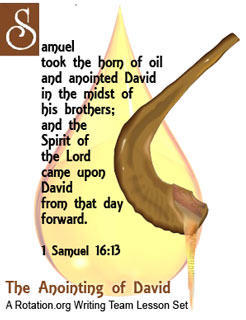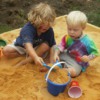Rotation.org Writing Team
Anointing of David
Art Workshop [1]
Summary of Lesson Activity
Children will create an "Outside-Inside" box to illustrate and remind them that people tend to judge the exterior appearance of a person (outside of the box, but God looks inside to see our heart (inside of the box).
Scripture
Passage: 1 Samuel 16:1-13
Key/Memory Verse: “For the Lord does not see as mortals see; they look on the outward appearance, but the Lord looks on the heart.” 1 Samuel 16:7b (NRSV)
Objectives for the Rotation
See Bible Background.
Preparation
- Read Bible Background and scripture.
- Find/order boxes.
- Collect plenty of magazines (Doctor's offices are a great source of old issues).
- Cut out several pictures of both Inside & Outside pictures for your examples.
- Do Google search for photos (see materials list directions).
Materials List
- Cardboard boxes, 1 per child, approximately 4 x 4 x 4 or about that size will work well, or a single much larger box for the "lit" version.
- Bibles
- Glue sticks
- Magazines (many!)
- Markers and a large piece of paper (butcher paper or poster paper)
- Scissors
- Various photos of people from a Google 'images' search of the phrase: "appearances can be deceiving examples" (see example below)
Lesson Plan
Open
Welcome the children.
"Appearances Can Be Deceiving" - Intro Activity:
 You will need photos you've clipped of four or five people from a Google "Image" search using the search phrase "appearances can be deceiving examples." Print several of the photos and write the real story on the back of the pictures.
You will need photos you've clipped of four or five people from a Google "Image" search using the search phrase "appearances can be deceiving examples." Print several of the photos and write the real story on the back of the pictures.
Hold up each photo and ask the children who they think the person is (example: What might they do for a living?)
The point is the kids will likely come up with the wrong conclusion about the person in your photo, and you'll reveal the real answer to make the point that "God knows us by what's in our heart, and that's how we should judge others as well, not by their appearance."
Say: Today we will be learning about the difference between how God sees us (judges us), and the way we see ourselves or the world sees us (judges us). You will make a "shadow" box to illustrate that point. Inside it, you will place images of what you think God wants to see in our hearts. But first, we will read the Bible passage using a "verse voting game"!
Dig
→This scripture voting technique helps students focus while listening and reading. ←
Reading and Voting the Scripture:
Draw two large hands on a large piece of paper placed in the middle of the students and write the word "Happy - Good" in one hand, and "Afraid - Sad" in the other. These are "voting hands."
Now take turns reading 1 Samuel 16:1-13 verse-by-verse, students vote on HOW SAMUEL MUST BE FEELING AT THAT MOMENT IN THAT VERSE. They 'vote' by placing and keeping their hand on one of the voting hands you've drawn.
This voting technique works especially well with this specific passage because there's a bit of a "see-saw" in the story as Samuel is presented with different sons to anoint. Students will have to change their vote many times, and this simple technique will thus make them pay closer attention to make voting decisions and so they don't feel left out of the action.
Follow-Up Questions (Discussion):
[Discussion Tip: You might write out some of these answers and important words on the paper that the students were voting on. Write out key part of verse 7 as well. This will give them a focal point and visual hook.]
- Did Samuel himself understand who God was looking for? (No. This is a lesson for even Samuel the great prophet!)
- What kind of candidates for king did Samuel first think God might choose? (the tall or older one)
- Thankfully, who is Samuel listening to during this entire selection process? (God!)
- What was it about David that caught Samuel's eye? They say your eyes are a "window to the soul?" What does that mean? (Suggest you invite students to demonstrate what "faithful" or "loving" eyes might look like.)
- Look at verse 7 and tell me what God is trying to say about people. What is it that God is looking for? What does God mean?
Reflect: The Reflection Box
[For an alternative "large and lit box" option, read the Additional Suggestions below.]
Give each student a box and explain that they are to find pictures in the magazines to either fit on the OUTSIDE or INSIDE of the box. Give them several examples that you have pre-cut from magazines. As you discuss the examples, write down several keywords on the piece of paper you used for the scripture voting -so that the students can refer to them while searching for images. As they search and as you discuss, continue writing new key ideas on the paper.
Outside: What the world says makes a person "good," "successful," "worthy," "popular," "happy." For example: money, cars, beauty, makeup, muscles, clothes, big house.
Inside: What God looks for inside a person. What God says makes a person "good" "successful" "worthy" "happy." For example: Heart, kind eyes, praying hands, cross, celebrating, helping others.
 As you find "inside" images, reinforce the central life application by asking, "What does God want to see in your heart that will make you a person after God's own heart?
As you find "inside" images, reinforce the central life application by asking, "What does God want to see in your heart that will make you a person after God's own heart?
Have everyone clip images to create the two piles for the class (rather than just each clipping their own). They'll probably find more "outside" images than inside, so at some point you may want to challenge the class to "only look for what God is looking for!" Help students think through the images they are clipping, and point things out to them which they may not have noticed in the magazines.
Teaching tip:
The "inside images" will be the more challenging to find -and this is where you as the teacher can do a lot of teaching! For example, a picture of one person helping another could go on the inside, or a picture of someone with loving eyes, holding hands, giving money, worshiping, praying, etc. As students find images for this category, have them explain what they think it means and then pile them up, so that others can use them on the inside of their box too.
When you have collected enough for both the outside and inside, pull out some examples and ask the students how that picture describes "outside" or "inside." Toss a marker to the student who answers and have them write their answer on the voting paper.
Before they paste the images on their box they need to, cut off two of the four box top flaps so that there are just two "barn door" flaps to open and see what's inside.
Then, begin gluing the "what the world judges others by" images on the outside of the box, and then "what God looks for on the inside of a person" on the inside of the box.
Invite them to write the KEY VERSE on a slip of paper and paste it on the inside as well.
Finish by making sure everyone has their name on their box and then pass them around for others to examine. Invite people to describe one or two things they put inside their box that they think is particularly good.
Close
Conclude the lesson by reviewing key ideas and then having a "laying on of hands" over all the boxes ("hand voting" again!) and a prayer that God will use these boxes to remind us that - as it was with Samuel and David, it's what on the inside of each of us that God cares about the most, and that we too should not judge others by appearances.
Instead of saying Amen, have each student say "Pick Me God!
Additional Suggestions
For Younger Children, or for more of a "Group" project:
- Working as a group, make one very large box with images inside and outside that can be placed on a table and displayed somewhere in the church for others to interact with.
- Cut several viewing holes in 3 of the box sides.
- Place a safe LED light source inside the box to illuminate the images inside. (a regular lightbulb will get too hot. LED rope light works well).
- Create a banner to go with the Box that has the key verse and some explanation of the project.
Written by Neil MacQueen based on an idea from Grace Buchanan,
with suggestions and formatting by Luanne Payne
Copyright © 2015 by Rotation.org
Printed from https://www.rotation.org

Children will create an "Outside-Inside" box to illustrate and remind them that people tend to judge the exterior appearance of a person (outside of the box, but God looks inside to see our heart (inside of the box).
tych," to tell the story of David. Pronounced, "trip-tik," it literally means "three fold."

 Welcome to the Rotation.org Writing Team's
Welcome to the Rotation.org Writing Team's







